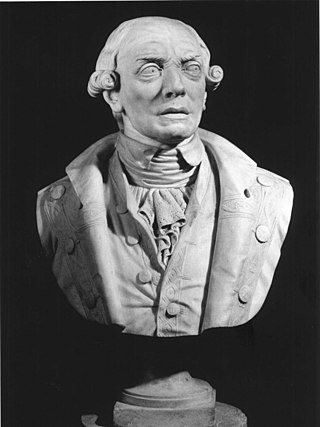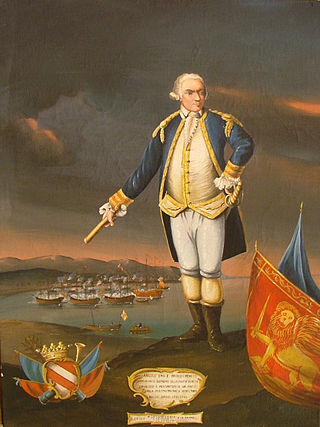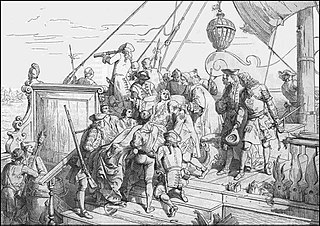Related Research Articles

The Battle of Lepanto was a naval engagement that took place on 7 October 1571 when a fleet of the Holy League, a coalition of Catholic states arranged by Pope Pius V, inflicted a major defeat on the fleet of the Ottoman Empire in the Gulf of Patras. The Ottoman forces were sailing westward from their naval station in Lepanto when they met the fleet of the Holy League which was sailing east from Messina, Sicily.

This indecisive naval battle took place on 8 July 1716 during a Turkish attempt to capture the island of Corfu (Kerkyra), off the west coast of mainland Greece.
A galley slave was a slave rowing in a galley, either a convicted criminal sentenced to work at the oar, or a kind of human chattel, sometimes a prisoner of war, assigned to the duty of rowing.

Angelo Emo was a Venetian noble, administrator, and admiral. He is notable for his reforms of the Venetian navy and his naval campaigns, being regarded as the last great admiral of the Venetian Republic.

The siege of Corfu took place on 8 July – 21 August 1716, when the Ottoman Empire besieged the city of Corfu, on the namesake island, then held by the Republic of Venice. The siege was part of the Seventh Ottoman–Venetian War, and, coming in the aftermath of the lightning conquest of the Morea by the Ottoman forces in the previous year, was a major success for Venice, representing its last major military success and allowing it to preserve its rule over the Ionian Islands.

The Venetian navy was the navy of the Venetian Republic which played an important role in the history of the republic and the Mediterranean world. It was the premier navy in the Mediterranean Sea for many centuries between the medieval and early modern periods, providing Venice with control and influence over trade and politics far in excess of the republic's size and population. It was one of the first navies to mount gunpowder weapons aboard ships, and through an organised system of naval dockyards, armouries and chandlers was able to continually keep ships at sea and rapidly replace losses. The Venetian Arsenal was one of the greatest concentrations of industrial capacity prior to the Industrial Revolution and responsible for the bulk of the republic's naval power.

The Venetian bombardments of the Beylik of Tunis were a series of naval bombardments of the capital and various port cities of the Beylik of Tunis by the Venetian navy in order to force Bey Hammuda ibn Ali to resume the treaty that protected Venetian-flagged shipping from harassment by Barbary pirates. The campaign lasted from 1784 to 1786, with the Venetian navy under Angelo Emo bombarding the harbour towns of Tunisia. The conflict dragged on until 1792, but no major naval actions were undertaken after the winter of 1786/87.

Riccardo Paladini was an Italian admiral during World War II.

The Captain General of the Sea was the wartime commander-in-chief of the Venetian navy.
The Captain of the Gulf was a senior naval command of the Republic of Venice.

The Provveditore Generale da Mar was the most senior peacetime office in the Venetian navy and in charge of governing the Venetian overseas empire.
A sopracomito was the captain of a galley in the Venetian navy. Elected from among those among the Venetian patriciate who already had some naval experience, the sopracomito was an important position and stepping-stone in the naval cursus honorum of the Republic of Venice. It entailed considerable responsibilities for crewing and maintaining a galley as well as great expenses, which made it increasingly the province of the wealthier patricians.
The Capitano delle Navi was a senior commander of the ships of the line of the navy of the Republic of Venice.

The Capitano Straordinario delle Navi was the senior wartime commander of the ships of the line of the navy of the Republic of Venice.
The Ottoman reconquest of the Morea took place in June–September 1715, during the Seventh Ottoman–Venetian War. The Ottoman army, under Grand Vizier Silahdar Damat Ali Pasha, aided by the fleet under Kapudan Pasha Canım Hoca Mehmed Pasha, conquered the Morea peninsula in southern Greece, which had been captured by the Republic of Venice in the 1680s, during the Sixth Ottoman–Venetian War. The Ottoman reconquest inaugurated the second period of Ottoman rule in the Morea, which ended with the outbreak of the Greek War of Independence in 1821.

Lodovico Flangini was a Venetian noble who served as Capitano Straordinario delle Navi during the Seventh Ottoman–Venetian War.

The Provveditore all'Armata or dell'Armata or d'Armata was a senior official and admiral of the Venetian navy. After the establishment of a sailing fleet next to the traditional galley fleet in the late 17th century, he was the most senior squadron admiral of the latter.
This is an alphabetical index of people, places, things, and concepts related to or originating from the Republic of Venice. Feel free to add more, and create missing pages.
The Provveditori all'Armar were officials of the Republic of Venice responsible for the provisioning and equipment of the ships and crews of the Venetian navy.
The Patron delle Navi, also Patrono or Patrona delle Navi, was a squadron commander of the ships of the line of the navy of the Republic of Venice.
References
- 1 2 Nani Mocenigo 1935, pp. 5, 23.
- 1 2 Nani Mocenigo 1935, p. 42.
- ↑ Nani Mocenigo 1935, pp. 41–42.
- ↑ Nani Mocenigo 1935, pp. 23, 28, 29.
- ↑ Nani Mocenigo 1935, pp. 30–31.
- ↑ Nani Mocenigo 1935, p. 28.
- 1 2 Nani Mocenigo 1935, p. 29.
